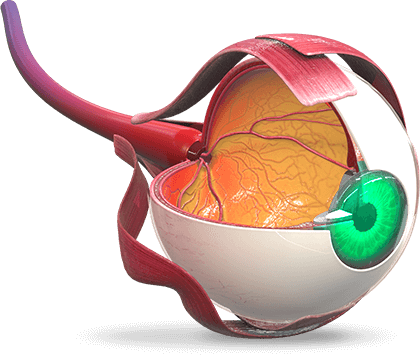Clinical Trials in PCV
Overview of Disease State
Polypoidal choroidal vasculopathy (PCV) is a subtype of neovascular age-related macular degeneration (nAMD) located above or within the Bruch membrane that has a high prevalence in people of Asian descent. [Ho.Sci Rep.2016][Oishi.Am J Ophthalmol.2013][Koh.JAMA Ophthalmol.2017] The prevalence has been reported to affect between 10% and 54% in people of Asian descent with nAMD, compared to between 8% and 12% of Caucasian patients with presumed nAMD. [Koh.Retina.2012] Untreated, the long-term prognosis of PCV is poor, with permanent vision loss occurring due to hemorrhage, exudation, macular edema, and disciform scar formation. [Koh.JAMA Ophthalmol.2017] [Lee.Graefes.2017]
PCV is typically characterized by an abnormal subretinal pigment epithelial network of vessels of choroidal origin, ending in aneurysmal dilatations, which appear as spheroidal polyp-like structures. [Koh.JAMA Ophthalmol.2017] Clinically, PCV often presents with subretinal pigment epithelium (sub-RPE) and/or subretinal hemorrhage and fluid accumulation; however, however, the clinical hallmark of PCV is considered to be the presence of orange-red, bulb-like structures growing from the choroid into the subretinal space, with associated adjacent serous pigment epithelial detachment (PED) or overlying neurosensory detachment, with subretinal hemorrhage and lipid (hard) exudates. [Koh.Retina.2012][Agrange.AAO EyeWiki.2021]
The use of anti-vascular endothelial growth factor (VEGF) agents with or without concurrent photodynamic therapy (PDT) has been shown to improve visual and anatomic prognoses. Summarized below are some of the more relevant studies supporting the use of anti-VEGF and/or PDT for PCV.
Click on the study name to see more details about each particular study. To enhance visibility of graphs and tables, click on the image to enlarge for expanding viewing.
Polypoidal Choroidal Vasculopathy Clinical Studies
References
Agrange N. Polypoidal choroidal vasculopathy. 2021. American Academy of Ophthalmology (AAO) EyeWiki. Accessed 12/3/2021. https://eyewiki.aao.org/Polypoidal_Choroidal_Vasculopathy.
Ho M, Woo DC, Chan VC, et al. Treatment of polypoidal choroidal vasculopathy by photodynamic therapy, aflibercept and dexamethasone triple therapy. Sci Rep. 2016;6:36870. doi:10.1038/srep36870
Koh A, Lee WK, Chen LJ, et al. EVEREST study: efficacy and safety of verteporfin photodynamic therapy in combination with ranibizumab or alone versus ranibizumab monotherapy in patients with symptomatic macular polypoidal choroidal vasculopathy. Retina. 2012;32(8):1453-1464. doi:10.1097/IAE.0b013e31824f91e8
Koh A, Lai TYY, Takahashi K, et al. Efficacy and safety of ranibizumab with or without verteporfin photodynamic therapy for polypoidal choroidal vasculopathy: a randomized clinical trial. JAMA Ophthalmol. 2017;135(11):1206-1213. doi:10.1001/jamaophthalmol.2017.4030
Lee JE, Shin JP, Kim HW, et al. Efficacy of fixed-dosing aflibercept for treating polypoidal choroidal vasculopathy: 1-year results of the VAULT study. Graefes Arch Clin Exp Ophthalmol. 2017;255(3):493-502. doi:10.1007/s00417-016-3489-5
Lee WK, Iida T, Ogura Y, et al. Efficacy and safety of intravitreal aflibercept for polypoidal choroidal vasculopathy in the PLANET study: a randomized clinical trial. JAMA Ophthalmol. 2018;136(7):786-793. doi:10.1001/jamaophthalmol.2018.1804
Lim TH, Lai TYY, Takahashi K, et al. Comparison of ranibizumab with or without verteporfin photodynamic therapy for polypoidal choroidal vasculopathy: The EVEREST II randomized clinical trial. JAMA Ophthalmol.2020;138(9):935-942. doi:10.1001/jamaophthalmol.2020.2443
Oishi A, Kojima H, Mandai M, et al. Comparison of the effect of ranibizumab and verteporfin for polypoidal choroidal vasculopathy: 12-month LAPTOP study results. Am J Ophthalmol. 2013 Oct;156(4):644-651. doi:10.1016/j.ajo.2013.05.024
Oishi A, Miyamoto N, Mandai M, et al. LAPTOP study: a 24-month trial of verteporfin versus ranibizumab for polypoidal choroidal vasculopathy. Ophthalmology. 2014;121(5):1151-1152.
Sakai T, Okano K, Kohno H, Tsuneoka H. Three-year visual outcomes of intravitreal ranibizumab with or without photodynamic therapy for polypoidal choroidal vasculopathy. Acta Ophthalmol. 2016;94(8):e765-e771.
Silva R, Arias L, Nunes S, et al. Efficacy and safety of intravitreal aflibercept treat and extend for polypoidal choroidal vasculopathy in the ATLANTIC Study: A randomized clinical trial. Ophthalmologica. 2022;245:80-90. https://www.karger.com/Article/FullText/518235

